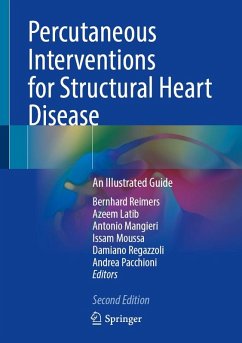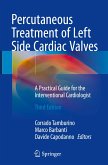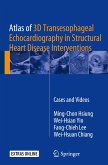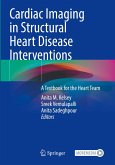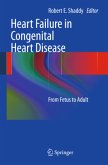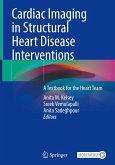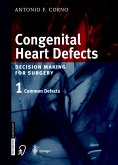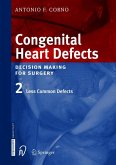Percutaneous Interventions for Structural Heart Disease
An Illustrated Guide
Herausgegeben:Reimers, Bernhard; Latib, Azeem; Mangieri, Antonio; Moussa, Issam; Regazzoli, Damiano; Pacchioni, Andrea
Percutaneous Interventions for Structural Heart Disease
An Illustrated Guide
Herausgegeben:Reimers, Bernhard; Latib, Azeem; Mangieri, Antonio; Moussa, Issam; Regazzoli, Damiano; Pacchioni, Andrea
- Gebundenes Buch
- Merkliste
- Auf die Merkliste
- Bewerten Bewerten
- Teilen
- Produkt teilen
- Produkterinnerung
- Produkterinnerung
The second edition of this book offers an overview of the percutaneous techniques and technologies most frequently employed in structural heart intervention, focusing on patient selection, preoperative evaluation, choice of available devices and outcome optimization. Interventional procedures for aortic stenosis, mitral regurgitation, left atrial appendage closure, patent foramen ovale closure, and closure of interatrial and interventricular defects are presented in a step by step fashion, and paralleled by informative illustrations. This new edition of Percutaneous Intervention for Structural…mehr
Andere Kunden interessierten sich auch für
![Percutaneous Treatment of Left Side Cardiac Valves Percutaneous Treatment of Left Side Cardiac Valves]() Percutaneous Treatment of Left Side Cardiac Valves85,99 €
Percutaneous Treatment of Left Side Cardiac Valves85,99 €![Atlas of 3D Transesophageal Echocardiography in Structural Heart Disease Interventions Atlas of 3D Transesophageal Echocardiography in Structural Heart Disease Interventions]() Ming-Chon HsiungAtlas of 3D Transesophageal Echocardiography in Structural Heart Disease Interventions119,99 €
Ming-Chon HsiungAtlas of 3D Transesophageal Echocardiography in Structural Heart Disease Interventions119,99 €![Cardiac Imaging in Structural Heart Disease Interventions Cardiac Imaging in Structural Heart Disease Interventions]() Cardiac Imaging in Structural Heart Disease Interventions64,99 €
Cardiac Imaging in Structural Heart Disease Interventions64,99 €![Heart Failure in Congenital Heart Disease: Heart Failure in Congenital Heart Disease:]() Heart Failure in Congenital Heart Disease:76,99 €
Heart Failure in Congenital Heart Disease:76,99 €![Cardiac Imaging in Structural Heart Disease Interventions Cardiac Imaging in Structural Heart Disease Interventions]() Cardiac Imaging in Structural Heart Disease Interventions100,99 €
Cardiac Imaging in Structural Heart Disease Interventions100,99 €![Congenital Heart Defects Congenital Heart Defects]() Antonio F. CornoCongenital Heart Defects106,99 €
Antonio F. CornoCongenital Heart Defects106,99 €![Congenital Heart Defects Congenital Heart Defects]() Antonio F. CornoCongenital Heart Defects38,99 €
Antonio F. CornoCongenital Heart Defects38,99 €-
-
-
The second edition of this book offers an overview of the percutaneous techniques and technologies most frequently employed in structural heart intervention, focusing on patient selection, preoperative evaluation, choice of available devices and outcome optimization. Interventional procedures for aortic stenosis, mitral regurgitation, left atrial appendage closure, patent foramen ovale closure, and closure of interatrial and interventricular defects are presented in a step by step fashion, and paralleled by informative illustrations. This new edition of Percutaneous Intervention for Structural Heart Disease aims to adjourn the reader on structural heart intervention not only as per current standard practice, but also on uprising topics such as percutaneous treatment of tricuspid regurgitation and paravalvular leak closure. Advances made in recent years, including introduction and optimization of transcatheter aortic valve implantation in patients with severe aortic stenosis independently from estimated surgical risk and implementation of percutaneous edge-to-edge mitral valve repair for functional mitral regurgitation, will be taken into account. The authors are all acknowledged experts with extensive experience in catheterization laboratories and surgical operating rooms.
Produktdetails
- Produktdetails
- Verlag: Springer / Springer International Publishing / Springer Nature Switzerland / Springer, Berlin
- Artikelnr. des Verlages: 89162227, 978-3-032-04994-0
- 2. Aufl.
- Seitenzahl: 516
- Erscheinungstermin: 12. März 2026
- Englisch
- Abmessung: 254mm x 178mm
- ISBN-13: 9783032049940
- ISBN-10: 3032049946
- Artikelnr.: 75068779
- Herstellerkennzeichnung
- Springer-Verlag GmbH
- Tiergartenstr. 17
- 69121 Heidelberg
- ProductSafety@springernature.com
- Verlag: Springer / Springer International Publishing / Springer Nature Switzerland / Springer, Berlin
- Artikelnr. des Verlages: 89162227, 978-3-032-04994-0
- 2. Aufl.
- Seitenzahl: 516
- Erscheinungstermin: 12. März 2026
- Englisch
- Abmessung: 254mm x 178mm
- ISBN-13: 9783032049940
- ISBN-10: 3032049946
- Artikelnr.: 75068779
- Herstellerkennzeichnung
- Springer-Verlag GmbH
- Tiergartenstr. 17
- 69121 Heidelberg
- ProductSafety@springernature.com
Bernard Reimers is Director of the Clinical and Invasive Cardiology Unit at Humanitas Research Hospital, Italy. Born in Germany, he earned his medical degree from the University of Padua in 1990, followed by a cardiology residency. After training at the Thoraxcenter in Rotterdam, he developed the cardiovascular program at Mirano Hospital. At Humanitas, he leads a high-volume program in coronary, peripheral, and structural heart interventions. A global expert in carotid angioplasty, Dr. Reimers has contributed extensively to research on myocardial infarction and primary angioplasty, publishing widely and performing live procedures at international conferences. He also organizes cardiology events such as TOBI, ETI, and MVSIC. Azeem Latib is System Director of Interventional Cardiology and Structural Heart Interventions at Montefiore Health System and Professor of Medicine at Albert Einstein College of Medicine, New York. An expert in interventional cardiology, he specializes in complex coronary procedures and transcatheter valve interventions (TAVR, TMVI, TTVI, and others). He earned his medical degree in 1995 from the University of Witwatersrand, South Africa, and completed advanced training in South Africa and Italy. Since 2019, he has led Montefiore’s interventional cardiology unit. His research focuses on structural heart devices, drug-coated balloons, and stents. Dr. Latib has authored over 900 peer-reviewed publications. He serves on editorial boards, international conference faculties, and is a member of the ACC and ESC. He is Global PI of multiple international and FDA-approved trials and has helped pioneer several novel interventional devices. Antonio Mangieri, MD, is an interventional cardiologist at Humanitas Research Hospital IRCCS in Rozzano, Milan. He earned his medical degree and completed cardiology residency at Vita-Salute San Raffaele University, where he also obtained a Master’s in Interventional Cardiology. His clinical and research interests include complex percutaneous coronary interventions, structural heart disease, and transcatheter valve therapies, with expertise in TAVI, mitral and tricuspid interventions, and intracoronary imaging. Dr. Mangieri has authored over 250 peer-reviewed publications, including work on conduction disturbances, valve-in-valve procedures, and imaging in complex PCI. He participates in multicenter trials and speaks regularly at international congresses such as EuroPCR and TCT. Issam D. Moussa is Professor and Head of the Department of Cardiovascular Medicine & Surgery at Carle Illinois College of Medicine, University of Illinois, Urbana-Champaign. He earned his medical degree from the University of Damascus and completed postgraduate studies at UC Irvine, Centro Cuore Columbus, and Lenox Hill Heart & Vascular Institute. A specialist in complex coronary and structural interventions, Dr. Moussa is a prolific researcher with numerous peer-reviewed publications. He serves on key committees of the ACC, AHA, and SCAI, including Chair of the ACC CathPCI Registry Steering Committee. Damiano Regazzoli is an interventional cardiologist at Humanitas Research Hospital. He graduated from the University of Brescia and completed training at Vita-Salute San Raffaele University. He joined Humanitas in 2018 and is active in national and international societies (GISE, ESC, EAPCI). His research focuses on bioresorbable scaffolds, TAVI, mitral/tricuspid interventions, and mechanical circulatory support. Andrea Pacchioni is an interventional cardiologist at Mirano Hospital, Italy. He graduated from the University of Milan and trained at the University of Verona. Since 2010, he has led interventional activities at Mirano and co-founded the CTO Club Triveneto. He is faculty at major meetings (TOBI, TCT, AIM Radial) and focuses on chronic total occlusions, transradial access, and high-risk interventions.
Preface.- Part 1.- Severe aortic stenosis treatment: percutaneous options, patient selection & preoperative evaluation.- Echocardiographic and magnetic resonance imaging evaluation.- Computed tomography: device and strategy planning.- Commercially available devices.- Everything you need to know about transfemoral route.- Alternative accesses: transcaval, transapical, transaxillary, transaortic and transcarotid.- How to manage hostile anatomies: large and small annuli, severely calcific anatomy, severe left ventricular outflow tract hypertrophy.- Transcatheter aortic valve implantation in bicuspid aortic valve.- How to avoid and manage acquired conduction disorders.- Valve-in-valve procedures as first-line strategy for degenerated aortic bioprosthesis.- Embolic protection devices in TAVR.- TAVR in patients at high risk of coronary obstruction: procedural considerations and management.- Future challenges: TAVI-in-TAVI procedures, asymptomatic aortic stenosis, moderate aortic stenosis, aortic stenosis and heart failure.- Future challenges: TRANSCATHETER AORTIC VALVE IMPLANTATION FOR PURE AORTIC REGURGITATION.- Difficult Cases and Complications from the Catheterization Laboratory: Case 3.- Difficult Cases and Complications from Catheterization Laboratory: Case 1.- Valve-in-Valve Transcatheter Aortic Valve Implantation (VIV-TAVI) with bioprosthetic aortic scallop intentional laceration to prevent iatrogenic coronary obstruction (BASILICA) and bioprosthetic valve fracture (BVF).- Self-Expanding Transcatheter Heart Valve Infolding: Different Clinical Presentations and Management.- Part 2.- Mitral regurgitation treatment: patient selection and procedural planning.- Multimodality imaging in transcatheter mitral valve interventions.- Coaptation augmentation devices.- Direct and Indirect Annuloplasty for Functional Mitral Regurgitation.- Percutaneous Interventions for Mitral Annular Calcification.- Transcatheter Mitral Valve Replacement.- Difficult Cases and Complications from Catheterization Laboratory: Case 3 - Structural device failure after MitraClip implantation due to iatrogenic chordal rupture.- Part 3.- Tricuspid regurgitation: from patient selection to procedural guiding with echocardiography.- Multimodality imaging in transcatheter tricuspid valve interventions.- Percutaneous tricuspid valve repair.- Transcatheter tricuspid valve replacement.- Caval valve implantation.- Valve-in-valve and valve-in-ring on tricuspid valve.- Transcatheter Edge to Edge Repair in a patient with tricuspid regurgitation due to a structural defect of the septal leaflet after surgical leaflet repair.- Part 4.- Percutaneous left atrial appendage closure: rational, patient selection, and preoperative evaluation.- Preprocedural Imaging for Left Atrial Appendage Occlusion.- LEFT ATRIAL APPENDAGE CLOSURE - Techniques & Devices.- Difficult Cases and Complications from the Catheterization Laboratory: Case 2.- Part 5.- Indications, imaging and patient selection for patent foramen ovale and interatrial defects.- Patent foramen ovale closure: from anatomy to device selection and step by step procedure.- Interatrial defects: techniques and devices.- Difficult cases and complications from the catheterization laboratory: a case of nitinol intolerance.- Difficult Cases and Complications from Catheterization Laboratory: Case 1 -Device embolization after PFO closure.- Paravalvular Regurgitation: Techniques, Access selection, and Devices.
Preface.- Part 1.- Severe aortic stenosis treatment: percutaneous options, patient selection & preoperative evaluation.- Echocardiographic and magnetic resonance imaging evaluation.- Computed tomography: device and strategy planning.- Commercially available devices.- Everything you need to know about transfemoral route.- Alternative accesses: transcaval, transapical, transaxillary, transaortic and transcarotid.- How to manage hostile anatomies: large and small annuli, severely calcific anatomy, severe left ventricular outflow tract hypertrophy.- Transcatheter aortic valve implantation in bicuspid aortic valve.- How to avoid and manage acquired conduction disorders.- Valve-in-valve procedures as first-line strategy for degenerated aortic bioprosthesis.- Embolic protection devices in TAVR.- TAVR in patients at high risk of coronary obstruction: procedural considerations and management.- Future challenges: TAVI-in-TAVI procedures, asymptomatic aortic stenosis, moderate aortic stenosis, aortic stenosis and heart failure.- Future challenges: TRANSCATHETER AORTIC VALVE IMPLANTATION FOR PURE AORTIC REGURGITATION.- Difficult Cases and Complications from the Catheterization Laboratory: Case 3.- Difficult Cases and Complications from Catheterization Laboratory: Case 1.- Valve-in-Valve Transcatheter Aortic Valve Implantation (VIV-TAVI) with bioprosthetic aortic scallop intentional laceration to prevent iatrogenic coronary obstruction (BASILICA) and bioprosthetic valve fracture (BVF).- Self-Expanding Transcatheter Heart Valve Infolding: Different Clinical Presentations and Management.- Part 2.- Mitral regurgitation treatment: patient selection and procedural planning.- Multimodality imaging in transcatheter mitral valve interventions.- Coaptation augmentation devices.- Direct and Indirect Annuloplasty for Functional Mitral Regurgitation.- Percutaneous Interventions for Mitral Annular Calcification.- Transcatheter Mitral Valve Replacement.- Difficult Cases and Complications from Catheterization Laboratory: Case 3 - Structural device failure after MitraClip implantation due to iatrogenic chordal rupture.- Part 3.- Tricuspid regurgitation: from patient selection to procedural guiding with echocardiography.- Multimodality imaging in transcatheter tricuspid valve interventions.- Percutaneous tricuspid valve repair.- Transcatheter tricuspid valve replacement.- Caval valve implantation.- Valve-in-valve and valve-in-ring on tricuspid valve.- Transcatheter Edge to Edge Repair in a patient with tricuspid regurgitation due to a structural defect of the septal leaflet after surgical leaflet repair.- Part 4.- Percutaneous left atrial appendage closure: rational, patient selection, and preoperative evaluation.- Preprocedural Imaging for Left Atrial Appendage Occlusion.- LEFT ATRIAL APPENDAGE CLOSURE - Techniques & Devices.- Difficult Cases and Complications from the Catheterization Laboratory: Case 2.- Part 5.- Indications, imaging and patient selection for patent foramen ovale and interatrial defects.- Patent foramen ovale closure: from anatomy to device selection and step by step procedure.- Interatrial defects: techniques and devices.- Difficult cases and complications from the catheterization laboratory: a case of nitinol intolerance.- Difficult Cases and Complications from Catheterization Laboratory: Case 1 -Device embolization after PFO closure.- Paravalvular Regurgitation: Techniques, Access selection, and Devices.

